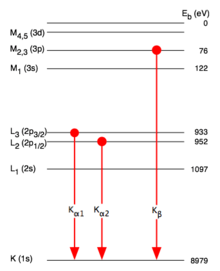Siegbahn notation
The Siegbahn notation is used in X-ray spectroscopy to name the spectral lines that are characteristic to elements. It was introduced by Manne Siegbahn.
The characteristic lines in X-ray emission spectra correspond to atomic electronic transitions where an electron jumps down to a vacancy in one of the inner shells of an atom. Such a hole in an inner shell may have been produced by bombardment with electrons in an X-ray tube, by other particles as in PIXE, by other X-rays in X-ray fluorescence or by radioactive decay of the atom's nucleus.
Although still widely used in spectroscopy, this notation is unsystematic and often confusing. For these reasons, International Union of Pure and Applied Chemistry (IUPAC) recommends another newer nomenclature. The table below shows a few of the common electronic levels with their names in Siegbahn and IUPAC notation.
| Low energy level | High energy level | Name of the line | IUPAC notation |
|---|---|---|---|
| K (1s−1) | L3 (2p3/2−1) | Kα1 | K-L3 |
| L2 (2p1/2−1) | Kα2 | K-L2 | |
| M3 (3p3/2−1) | Kβ1 | K-M3 | |
| M2 (3p1/2−1) | Kβ3 | K-M2 | |
| L3 (2p3/2−1) | M5 (3d5/2−1) | Lα1 | L3-M5 |
| L2 (2p1/2−1) | M4 (3d3/2−1) | Lβ1 | L2-M4 |
| M5 (3d5/2−1) | N7 (4f7/2−1) | Mα1 | M5-N7 |
K-alpha

K-alpha emission lines result when an electron transitions to the innermost "K" shell (principal quantum number 1) from a 2p orbital of the second or "L" shell (with principal quantum number 2). The line is actually a doublet, with slightly different energies depending on spin-orbit interaction energy between the electron spin and the orbital momentum of the 2p orbital. K-alpha is typically by far the strongest X-ray spectral line for an element bombarded with energy sufficient to cause maximally intense X-ray emission.
The analogous K-alpha spectra line in hydrogen is known as Lyman alpha; however because of hydrogen's small nuclear charge, this line is in the ultraviolet, not the X-ray range.
An example of K-alpha lines are those seen for iron as iron atoms radiating X-rays spiralling into a black hole at the center of a galaxy.[1] For such purposes, the energy of the line is adequately calculated to 2-digit accuracy by the use of Moseley's law: , where Z is the atomic number. For example, K-alpha for iron (Z = 26) is calculated in this fashion as 10.2 eV (25)2 = 6.38 keV energy. For astrophysical purposes, Doppler and other effects (such as gravitational broadening) show the iron line to no better accuracy than 6.4 keV.[2]
Values of Transition Energies
- Values of different kinds of transition energies like K, K, L, L and so on for different elements can be found in the NIST X-Ray Transition Energies Database and Spectr-W3 Atomic Database for Plasma Spectroscopy [3]
- K-alpha emission values for hydrogen-sum and helium-like ions can be found on Table 1-5 of the LBNL X-Ray Data Booklet [4]
K-beta
K-beta emissions, similar to K-alpha emissions, result when an electron transitions to the innermost "K" shell (principal quantum number 1) from a 3p orbital of the third or "M" shell (with principal quantum number 3).
Values can be found in the X-Ray Transition Energies Database.[5]
See also
References
- ↑ Fukumura, Keigo; Tsuruta, Sachiko (2004-10-01). "Iron Kα Fluorescent Line Profiles from Spiral Accretion Flows in Active Galactic Nuclei". The Astrophysical Journal. 613 (2): 700–709. doi:10.1086/423312.
- ↑ Lee, Julia C.; Iwasawa, Kazushi; Houck, John C.; Fabian, Andrew C.; Marshall, Herman L.; Canizares, Claude R. (2002-05-10). "The Shape of the Relativistic Iron Kα Line from MCG −6-30-15 Measured with the [ITAL]Chandra[/ITAL] High Energy Transmission Grating Spectrometer and the [ITAL]Rossi X-Ray Timing Explorer[/ITAL]". The Astrophysical Journal. 570 (2): L47–L50. doi:10.1086/340992.
- ↑ Spectr-W3 database
- ↑ Lawrence Berkeley National Laboratory X-Ray Data Booklet
- ↑ NIST X-Ray Transition Energies Database